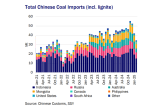Research
09/04/25
Chemicals Update: The US / China Trade War – Implications for the Chemical Tanker Market

Say hello to the new world trade (dis)order.
Initiated by Donald Trump, the US is in the midst of exchanging tariff blows with most of the world. Aside from the questionable economic logic behind the sweeping tariffs announced on 2 April, countries now have to live and get accustomed to this new tariff regime.
In this fight China has been singled out as the biggest culprit for American economic troubles and has been awarded a total tariff rate of 54%. Departing from its measured responses from the past couple of years, this time China responded with a tariff of its own – 34% on all imports from the US. Not to be outdone, President Trump hit back and imposed an additional 50% on Chinese goods coming into the US.
How does this affect trade flows?
In the bulk liquid chemicals at least, the impact will not be so severe as in finished goods, for example. But impact there will be, and US glycols exports may be the most affected.
China imports between 800,000 and 1,000,000 mt of glycols per year from the US. With the 34% tariff, US product becomes decidedly uncompetitive compared to other alternatives. This will likely mean the end of spot US glycols exports, cutting around 200,000 mt for the remainder of this year. This may not sound like a lot, but it will put downward pressure on the Transpacific lane to Asia. If the situation persists, it could be expected that next year US glycol volumes will be sharply lower as both spot and contractual cargoes disappear.
Looking from the other side of the Pacific, besides used cooking oil and related biofuel feedstocks, China does not export big quantities of liquid bulk chemicals to the US. But import tariffs aside, these volumes have already been reduced significantly as the Trump administration is disincentivising the biofuels production from such feedstocks.
It is difficult to predict how everything will play out, however as things currently stand, it is beyond doubt that the chemical tanker market on the Transpacific trade lane will weaken further in the coming weeks and months – perhaps significantly.
Shipowners who are now heavily contracted from the USG to Asia may find this new environment very challenging as the volumes around which they have built their portfolios are no longer there. They will have to rely more on the spot market, which may result in lower spot freight rates.
On the other hand, high uncertainty, potentially higher US port fees, and the relative lack of cargoes back to Asia may see more reluctance from shipowners to send their vessels to the US. This is already happening and leading to relatively higher freight rates from Asia to the USG – a further hindrance to trade.
All of this is, of course, highly speculative and tomorrow may be completely irrelevant or outdated. But what remains clear is that that extreme uncertainty is here to stay, and this is not good for trade, investment and the economy as a whole. And the sooner these trade disputes are resolved, the better.
By Plamen Aleksandrov, Head of Research – Chemicals, SSY.
Articles
You may also be
interested in
View allGet in touch
Contact us today to find out how our expert team can support your business













